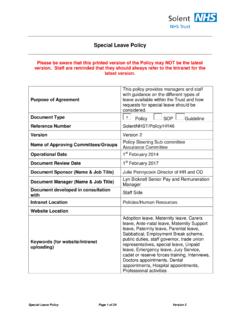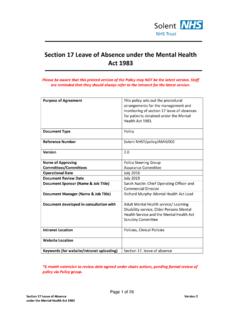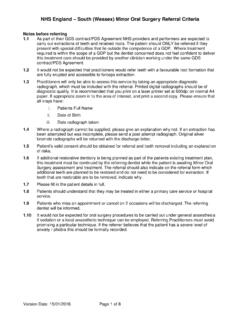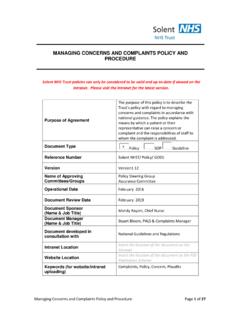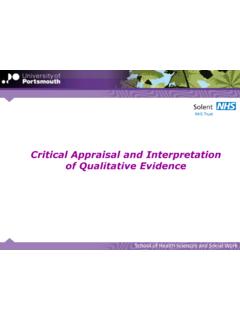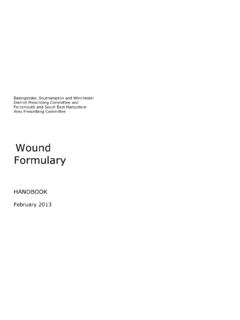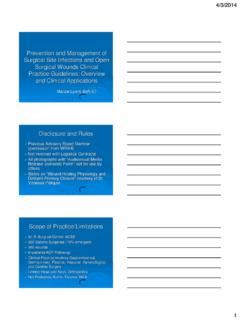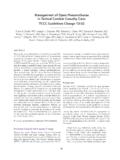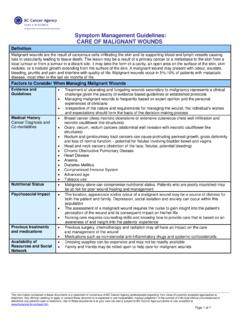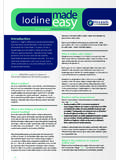Transcription of Tissue Viability Policy The Prevention & …
1 Tissue Viability Policy Version 2 Page 1 of 35 Tissue Viability Policy The Prevention & Management of Wounds Solent NHS Trust policies can only be considered to be valid and up-to-date if viewed on the intranet. Please visit the intranet for the latest version. Purpose of Agreement This Policy sets out the required standard to be delivered by Solent NHS Trust Solent NHS Trust Care staff for all patients with / or at risk of Tissue breakdown to promote optimum healing and improved clinical outcomes where Document Type Policy Reference Number Solent NHST/ Policy / PC/N/01 Version Version 2 .14/04/2016 Name of Approving Committees/Groups Policy Steering Group, Assurance Committee Operational Date June 2016 Document Review Date June 2019 Document Sponsor (Name & Job Title) Mandy Rayani Chief Nurse Document Manager (Name & Job Title)
2 Pamela Wood Clinical Advisor Pressure Relief Monique Rosell Clinical Manager Tissue Viability Document developed in consultation with Sarah Oborne Quality & Training Lead June Dutton Clinical Advisor Pressure Relief Margaret Simmonds Tissue Viability Nurse Laura Evans Tissue Viability Nurse Sally Reynolds Tissue Viability Nurse Tissue Viability Steering Group Governance Leads Intranet Location Policy /Clinical Website Location Insert the location of the document on the FOI Publication Scheme Keywords (for website/intranet uploading) Tissue Viability / wound Care Tissue Viability Policy Version 2 Page 2 of 35 Amendments Summary: Amend No Issued Page Subject Action Date 1 3 Signpost readers to SOP for Leg Ulcers & Pressure Ulcers 26/05/2016 2 6 Addition of Pain Assessment 26/05/2016 3 6 Addition of Nutrition & Hydration & linked to Policy SLT001 26/05/2016 4 7 Linked to Infection Prevention Control Policy IPC01/IPC10 Referral process for Portsmouth & Southampton Tissue Viability Service.
3 26/05/2016 5 7 Update to definition of pressure ulcers from new EPUAP Guidelines 2014 26/05/2016 6 8 Foot Wounds included in Policy 26/05/2016 7 9 Leg Ulcers included in Policy 26/05/2016 8 10 Development of bespoke training as required 26/05/2016 9 Appendix E Updated in RCA From to use Preventable terminology in decision making process at Pressure Ulcer Panel 26/05/2016 Review Log: Version Number Review Date Lead Name Ratification Process Notes Feb 2012 Denise Woodd Tissue Viability Policy Version 2 Page 3 of 35 Tissue Viability Policy The Prevention & Management of Wounds SUMMARY OF Policy Tissue Viability is a growing speciality that primarily considers all aspects of skin and soft Tissue wounds including acute surgical wounds, pressure ulcers and all forms of leg ulceration.
4 " - ( Tissue Viability Society 2009). This Policy is over-arching to encompass Tissue Viability in its broadest sense. To support specific wound care the associated Standard Operating Procedures for Leg Ulcers & for Pressure ulcers needs to be read in conjunction with this Policy . Wounds can have many causes trauma; surgery; ischaemia; infection; pressure; chemical; burn or disease and affect any person of any age in any health care setting. Wounds healing by Primary intention usually heal quickly and without complication (Hampton and Collins 2004). Most wounds created by surgery, heal either by primary closure, or planned healing by secondary intention and heal without delay. Wounds healing by Secondary intention usually heal more slowly, and if not managed correctly often result in non-healing, presenting the biggest challenge for clinicians (Hampton and Collins 2004).
5 Non-healing wounds are the most likely cause of skin and soft Tissue infections. Wounds colonised with MRSA are especially at increased risk for both wound infection and systemic infection. (Demling and Waterhouse 2007). Non-healing wounds affect patients lives emotionally, mentally, physically, socially and in some patients, impact on working capacity and job security (Herber et al 2007). They can be central in preventing full recovery, increasing hospital stays and increasing the need for ongoing treatments (Spilsbury et al 2007). Non - healing is often associated with lack of appropriate patient assessment and management resulting in an increased risk of complications and patient suffering (Posnett and Franks 2008).
6 Non-healing leads to chronicity - There were an estimated million wounds managed by the NHS in 2012/2013. Annual levels of resource use attributable to managing these wounds and associated comorbidities included million practice nurse visits, million community nurse visits, million GP visits and million hospital outpatient visits. The annual NHS cost of managing these wounds and associated comorbidities was billion. This was reduced to between and billion after adjusting for comorbidities. (Health economic burden that wounds impose on the National Health Service in the UK Dec 2015) Tissue Viability Policy Version 2 Page 4 of 35 Table of Contents Item Contents Page 1 INTRODUCTION AND PURPOSE 5 2 SCOPE AND DEFINITION 5 3 PROCESS/REQUIREMENTS 6 4 ROLES & RESPONSIBILITIES 9 5 TRAINING 10 6 EQUALITY IMPACT ASSESSMENT AND MENTAL CAPACITY 10 7 SUCCESS CRITERIA / MONITORING EFFECTIVENESS 10 8 REVIEW 11 9 REFERENCES AND LINKS TO OTHER DOCUMENTS 11 Appendixes Appendix A : Equality Impact Assessment 13 Appendix B: Portsmouth Referral for specialist Tissue Viability Advice 15 Appendix C: Southampton Tissue Viability Referral 19 Appendix D: Main Provider Check List 24 Appendix E.
7 Root Cause Analysis Form for Pressure Ulcers category 3 & 4 acquired in Solent NHS Trust Care 25 Tissue Viability Policy Version 2 Page 5 of 35 1. INTRODUCTION & PURPOSE This Policy sets out the required standard of care for all patients with / or at risk of Tissue breakdown. It has been developed in line with current evidence, national guidance and consensus opinion to reduce the incidence of Tissue breakdown and where Tissue breakdown has occurred, promote complete healing where possible. In the case of patients whose wound and /or disease are unresponsive to curative treatment, it sets standards to minimise wound complications, manage symptoms and provide patient comfort. It should be read along with the Standard Operating Procedure for the type of wound being treated.
8 The required standard will ensure patients receive timely and regular assessment, management and review, with appropriate Prevention and referral defined for their care, reflecting both their wound care and more general physical and psychological needs. This will be achieved by the following objectives: Ensure appropriate staff are familiar with all other policies and standard operating procedures linked to Tissue Viability and ensure accessibility to documents. Provide education and training linked to competency assessment for all clinical staff in relation to assessment, diagnosis, management, Prevention , monitoring and referral as appropriate to their role. Ensure all staff are proactive in early assessment and intervention to prevent complications and promote wound healing.
9 Ensure all staff are compliant with consistent high quality documentation and record keeping to provide continuity of care and to determine patient outcomes. Ensure all staff use the local wound care formulary to guide clinical and cost effective treatment choices. Support staff to educate patients/carers in wound management and Prevention strategies by ensuring they receive up-to-date written and verbal information. Ensure all appropriate staff are aware of the process for reporting & reviewing patients with a pressure ulcer. 2. SCOPE & DEFINITIONS This document applies to Solent NHS Trust staff/employees; who are directly and indirectly employed staff within Solent NHS Trust and other persons working within the organisation in line with Solent NHS Trust s Equal Opportunities Document.
10 This document is also recommended to Independent Contractors as good practice. This is an overarching Policy . Primary intention - refers to a closed wound were the wound edges are brought together in approximation by sutures in surgical wounds. Secondary intention - refers to an open wound were the wound edges close by the processes of granulation and epithelialisation pressure ulcers, leg ulcers Tissue Viability Policy Version 2 Page 6 of 35 wound - Refers to a break in the skin anywhere on the body which is either partial or full thickness skin loss due to any cause self-harm, surgery, trauma, infection, disease, pressure, friction, shear, moisture.
